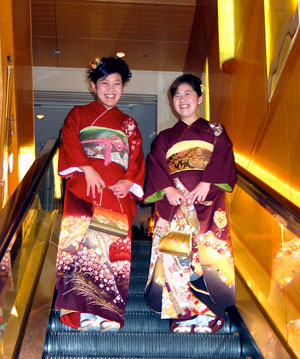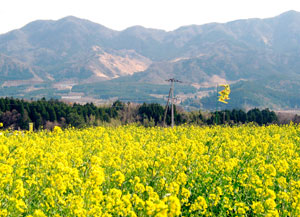TOKYO – In a country renowned for its high-speed trains, it was two slow moving versions - one known as the “Romance Car” - that made us fall in love with rail service here.
“Can we make it?” my companion asked as we raced to catch the legendary Romance Car at Tokyo’s Shinjuku Station one early summer’s morning.
“We can if we hurry — I know it (the train) won’t be late,” I shot back as we huffed and puffed our way past an army of black-suited male workers headed into Tokyo’s forest of office towers.
We quickly discovered on our Japanese journey that trains are NEVER late here. If the departure time says 9 a.m., the train ALWAYS pulls out at 9:01 a.m.
“Made it!” I exclaimed while bracing myself up against a sleek silver carriage, catching my breath after arriving on the platform a few minutes ahead of the train’s scheduled departure.
The Romance Car is so named because many honeymooners once used the train to get to Hakone, the idyllic resort town known as Japan’s version of England’s Lake District where mountain waterfalls and active volcanoes highlight a jaw-dropping gorgeous landscape.
While not as fast as Japan’s legendary shinkansen (bullet trains), the Romance Car was still faster than those we were used to back in North America, and we quickly covered the 67 mile distance to Hakone — arriving there in just over 45 minutes.
From Hakone we planned to travel to tiny Chokokunomori, site of the Hakone Open Air Art Museum, aboard another well-known Japanese train called the Tozan.


Left: Shy Japanese women smile for a stranger. Right: Fast-moving trains blur to countryside.
“This looks like the Little Train That Could from those children’s story books,” my traveling companion observed as the tiny fire-engine red Tozan slowly chugged into Hakone’s main rail station.
Locals from the small mountain villages surrounding Hakone scurried from the Tozan and disappeared down the platform. A muffled voice bellowed from a loudspeaker, but the Japanese words meant little to us. (Once out of Tokyo and other major centers, train instructions are almost always given in Japanese, we discovered.)
The Tozan’s sharp whistle soon signalled it was time to leave and a few minutes later the small train began its slow, steady climb towards Chokokunomori, the mountain-top town chosen as the site for the art museum because of its breathtaking views of the surrounding valley.
The train got swallowed by the dense forest it passes through en route to Chokokunomori and the car quickly filled with the sharp smell of fresh pine. In the distance, we could see liquid smoke rising from cascading waterfalls.
This area of Japan has become an oasis for nature and spa lovers, who come to soak up the healing powers of the natural hot springs that bubble to the surface here.
The tiny train zig-zagged up the imposing mountain, stopping to let villagers off at neatly-kept towns along the way. Soon it was our turn to disembark at Chokokunomori, where a fellow traveler and frequent visitor to the museum, told us to follow her to the entrance.
“This is my fifth visit here,” boasted Elizabeth, an art student from New York City. “I first came to see the works of Picasso and Henry Moore but I keep coming back because this is one of the most beautiful places I have ever visited.”
The museum opened in 1969 and is home to over 100 world renowned masterpieces — great works from Rodin, Bourdelle, Miro and Moore, most of which are displayed in open air gardens overlooking the magnificent endless landscape.
The museum’s main pavilion houses the works of master painters, among them a great collection of Renoirs. Picasso, who is held in great esteem in Japan, has his own pavilion at Hakone, where over 300 of his abstract works are displayed. Most of the exhibition is made up of pottery purchased from Picasso’s eldest daughter, Maya Picasso. There are also excellent examples of his paintings, prints and sculptures.
Walking the museum’s manicured grounds proved to be just as rewarding – Moore’s works are scattered about the property and are especially impressive.
Later that day we retraced our tracks, taking the Tozan back to Hakone and then the Romance Car back to Tokyo.
Our first introduction to Japanese rail travel wasn’t our last, though. Inspired by the Hakone outing, we later jumped aboard the shinkansen for a bullet-like ride from Tokyo to Kyoto, covering the 600-kilometre distance in less than three hours and at speeds in excess of 280 kilometres per hour.
In a country that owes much of its wealth and stature to the motor car, the railway is still Japan’s transportation lifeline. And the network of steel veins that runs through this industrial giant is its strength.
The bullet trains have been the envy of the world since they first pulled into Japan’s rail stations over 20 years ago. And while the speed of the trains amazes, it’s the cleanliness of the cars that really impresses.
The shinkansen experience isn’t cheap — a first-class fare can run as high as $170 U.S. and economy fares start at $120 U.S. But the thrill is priceless.
There are things you must be aware of when traveling on trains in Japan. While announcements on the shinkansen are made in Japanese and English, local train announcements are almost always unilingual.
And beware! Don’t throw your ticket stub away. You’ll need it to get out of the station at your destination.
Besides being ultra-clean (what else would you expect in Japan?) the trains here are ruled by no nonsense conductors who keep an close eye on offenders of the strict “no cell phone use” rule that is applied on shinkansen line trains.
If you do need to use a cellphone, you have to do it in the gap between cars. If your phone should ring during the trip, expect to be stared down by fellow passengers and the conductor.
There’s a whole set of rules you should learn before jumping aboard a Japanese train and you can learn more by going to the Japan Railways Group website, www.japanrail.com
For us, the Romance Car and Japanese train travel was love at first sight.